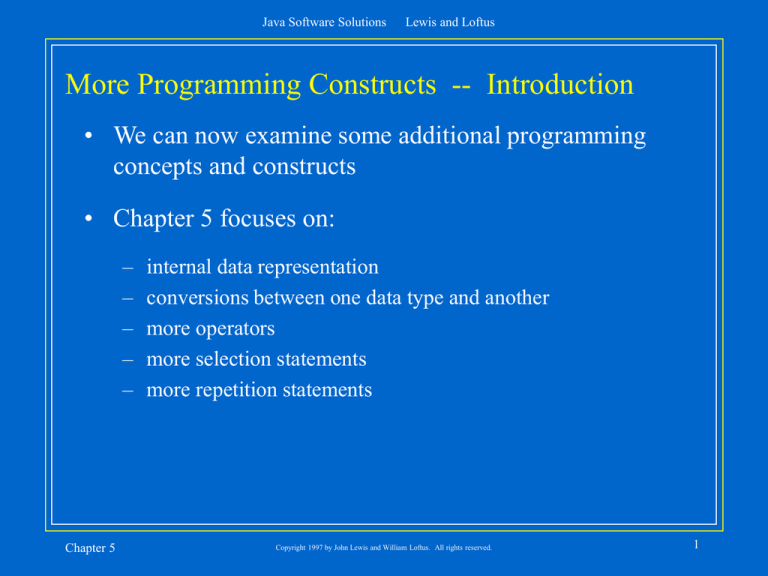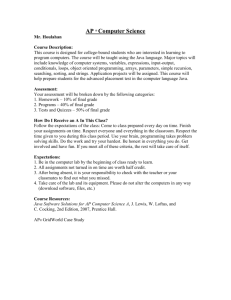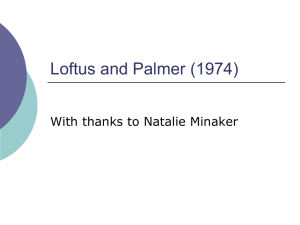More Programming Constructs -- Introduction concepts and constructs
advertisement

Java Software Solutions
Lewis and Loftus
More Programming Constructs -- Introduction
• We can now examine some additional programming
concepts and constructs
• Chapter 5 focuses on:
–
–
–
–
–
Chapter 5
internal data representation
conversions between one data type and another
more operators
more selection statements
more repetition statements
Copyright 1997 by John Lewis and William Loftus. All rights reserved.
1
Java Software Solutions
Lewis and Loftus
Internal Data Representation
• We discussed earlier that every piece of information
stored on a computer is represented as binary values
• What is represented by the following binary string?
01100001001010
• You can't tell just from the bit string itself.
• We take specific binary values and apply an
interpretation to them
Chapter 5
Copyright 1997 by John Lewis and William Loftus. All rights reserved.
2
Java Software Solutions
Lewis and Loftus
Representing Integers
• There are four types of integers in Java, each providing a
different bits to store the value
• Each has a sign bit. If it is 1, the number is negative; if
it is 0, the number is positive
byte
s
short
s
int
s
long
s
Chapter 5
7 bits
15 bits
31 bits
63 bits
Copyright 1997 by John Lewis and William Loftus. All rights reserved.
3
Java Software Solutions
Lewis and Loftus
Two's Complement
• Integers are stored in signed two's complement format
• A positive value is a straightforward binary number
• A negative value is represented by inverting all of the
bits of the corresponding positive value, then adding 1
• To "decode" a negative value, invert all of the bits and
add 1
• Using two's complement makes internal arithmetic
processing easier
Chapter 5
Copyright 1997 by John Lewis and William Loftus. All rights reserved.
4
Java Software Solutions
Lewis and Loftus
Two's Complement
• The number 25 is represented in 8 bits (byte) as
00011001
• To represent -25, first invert all of the bits
11100110
then add 1
11100111
• Note that the sign bit reversed, indicating the number is
negative
Chapter 5
Copyright 1997 by John Lewis and William Loftus. All rights reserved.
5
Java Software Solutions
Lewis and Loftus
Overflow and Underflow
• Storing numeric values in a fixed storage size can lead to
overflow and underflow problems
• Overflow occurs when a number grows too large to fit in
its allocated space
• Underflow occurs when a number shrinks too small to fit
in its allocated space
• See Overflow.java
Chapter 5
Copyright 1997 by John Lewis and William Loftus. All rights reserved.
6
Java Software Solutions
Lewis and Loftus
Representing Floating Point Values
• A decimal (base 10) floating point value can be defined
by the following equation
sign * mantissa * 10 exponent
• where
– sign is either 1 or -1
– mantissa is a positive value that represents the significant digits
of the number
– exponent is a value that indicates how the decimal point is
shifted relative to the mantissa
Chapter 5
Copyright 1997 by John Lewis and William Loftus. All rights reserved.
7
Java Software Solutions
Lewis and Loftus
Representing Floating Point Values
• For example, the number -843.977 can be represented by
-1 * 843977 * 10 -3
• Floating point numbers can be represented in binary the
same way, except that the mantissa is a binary number
and the base is 2 instead of 10
sign * mantissa * 2 exponent
• Floating point values are stored by storing each of these
components in the space allotted
Chapter 5
Copyright 1997 by John Lewis and William Loftus. All rights reserved.
8
Java Software Solutions
Lewis and Loftus
Representing Characters
• As described earlier, characters are represented according
to the Unicode Character Set
• The character set matches a unique number to each
character to be represented
• Storing the character is therefore as simple as storing the
binary version of the number that represents it
• For example, the character 'z' has the Unicode value
122, which is represented in 16 bits as
0000000001111010
Chapter 5
Copyright 1997 by John Lewis and William Loftus. All rights reserved.
9
Java Software Solutions
Lewis and Loftus
Representing Characters
• Because they are stored as numbers, Java lets you
perform some arithmetic processing on characters
• For example, because 'A' is stored as Unicode value 65,
the statement
char ch = 'A' + 5;
will store the character 'F' in ch (Unicode value 70)
• This relationship is occasionally helpful
Chapter 5
Copyright 1997 by John Lewis and William Loftus. All rights reserved.
10
Java Software Solutions
Lewis and Loftus
Conversions
• Each data value and variable is associated with a
particular data type
• It is sometimes necessary to convert a value of one data
type to another
• Not all conversions are possible. For example, boolean
values cannot be converted to any other type and vice
versa
• Even if a conversion is possible, we need to be careful
that information is not lost in the process
Chapter 5
Copyright 1997 by John Lewis and William Loftus. All rights reserved.
11
Java Software Solutions
Lewis and Loftus
Widening Conversions
• Widening conversions are generally safe because they go
from a smaller data space to a larger one
• The widening conversions are:
Chapter 5
From
To
byte
short
char
int
long
float
short, int, long, float, or double
int, long, float, or double
int, long, float, or double
long, float, or double
float or double
double
Copyright 1997 by John Lewis and William Loftus. All rights reserved.
12
Java Software Solutions
Lewis and Loftus
Narrowing Conversions
• Narrowing conversions are more dangerous because they
usually go from a smaller data space to a larger one
• The narrowing conversions are:
Chapter 5
From
To
byte
short
char
int
long
float
double
char
byte or char
byte or short
byte, short, or char
byte, short, char, or int
byte, short, char, int or long
byte, short, char, int, long, or float
Copyright 1997 by John Lewis and William Loftus. All rights reserved.
13
Java Software Solutions
Lewis and Loftus
Performing Conversions
• In Java, conversion between one data type and another
can occur three ways
• Assignment conversion - when a value of one type is
assigned to a variable of another type
• Arithmetic promotion - occurs automatically when
operators modify the types of their operands
• Casting - an operator that forces a value to another type
Chapter 5
Copyright 1997 by John Lewis and William Loftus. All rights reserved.
14
Java Software Solutions
Lewis and Loftus
Assignment Conversion
• For example, if money is a float variable and
dollars is an int variable (storing 82), then
money = dollars;
converts the value 82 to 82.0 when it is stored
• The value in dollars is not actually changed
• Only widening conversions are permitted through
assignment
• Assignment conversion can also take place when passing
parameters (which is a form of assignment)
Chapter 5
Copyright 1997 by John Lewis and William Loftus. All rights reserved.
15
Java Software Solutions
Lewis and Loftus
Arithmetic Promotion
• Certain operators require consistent types for their
operands
• For example, if sum is a float variable and count is
an int variable, then the statement
result = sum / count;
internally converts the value in count to a float then
performs the division, producing a floating point result
• The value in count is not changed
Chapter 5
Copyright 1997 by John Lewis and William Loftus. All rights reserved.
16
Java Software Solutions
Lewis and Loftus
Casting
• A cast is an operator that is specified by a type name in
parentheses
• It is placed in front of the value to be converted
• The following example truncates the fractional part of
the floating point value in money and stores the integer
portion in dollars
dollars = (int) money;
• The value in money is not changed
• If a conversion is possible, it can be done through a cast
Chapter 5
Copyright 1997 by John Lewis and William Loftus. All rights reserved.
17
Java Software Solutions
Lewis and Loftus
More Operators
• We've seen several operators of various types:
arithmetic, equality, relational
• There are many more in Java to make use of:
–
–
–
–
Chapter 5
increment and decrement operators
logical operators
assignement operators
the conditional operator
Copyright 1997 by John Lewis and William Loftus. All rights reserved.
18
Java Software Solutions
Lewis and Loftus
The Increment and Decrement Operators
• The increment operator (++) adds one to its integer or
floating point operand
• The decrement operator (--) subtracts one
• The statement
count++;
is essentially equivalent to
count = count + 1;
Chapter 5
Copyright 1997 by John Lewis and William Loftus. All rights reserved.
19
Java Software Solutions
Lewis and Loftus
The Increment and Decrement Operators
• The increment and decrement operators can be applied in
prefix (before the variable) or postfix (after the variable)
form
• When used alone in a statement, the prefix and postfix
forms are basically equivalent. That is,
count++;
is equivalent to
++count;
Chapter 5
Copyright 1997 by John Lewis and William Loftus. All rights reserved.
20
Java Software Solutions
Lewis and Loftus
The Increment and Decrement Operators
• When used in a larger expression, the prefix and postfix
forms have a different effect
• In both cases the variable is incremented (decremented)
• But the value used in the larger expression depends on
the form
Expression
Operation
Value of Expression
count++
++count
count---count
add 1
add 1
subtract 1
subtract 1
old value
new value
old value
new value
Chapter 5
Copyright 1997 by John Lewis and William Loftus. All rights reserved.
21
Java Software Solutions
Lewis and Loftus
The Increment and Decrement Operators
• If count currently contains 45, then
total = count++;
assigns 45 to total and 46 to count
• If count currently contains 45, then
total = ++count;
assigns the value 46 to both total and count
Chapter 5
Copyright 1997 by John Lewis and William Loftus. All rights reserved.
22
Java Software Solutions
Lewis and Loftus
The Increment and Decrement Operators
• If sum contains 25, then the statement
System.out.println (sum++ + "
"
" + sum + "
" + ++sum +
" + sum--);
prints the following result:
25
27
27
27
and sum contains 26 after the line is complete
Chapter 5
Copyright 1997 by John Lewis and William Loftus. All rights reserved.
23
Java Software Solutions
Lewis and Loftus
Logical Operators
• There are three logical operators in Java:
Operator
Operation
!
&&
||
Logical NOT
Logical AND
Logical OR
• They all take boolean operands and produce boolean
results
• Logical NOT is unary (one operand), but logical AND
and OR are binary (two operands)
Chapter 5
Copyright 1997 by John Lewis and William Loftus. All rights reserved.
24
Java Software Solutions
Lewis and Loftus
Logical NOT
• The logical NOT is also called logical negation or logical
complement
• If a is true, !a is false; if a is false, then !a is true
• Logical expressions can be shown using truth tables
Chapter 5
a
!a
false
true
true
false
Copyright 1997 by John Lewis and William Loftus. All rights reserved.
25
Java Software Solutions
Lewis and Loftus
Logical AND
• The expression a && b is true if both a and b are true,
and false otherwise
• Truth tables show all possible combinations of all terms
Chapter 5
a
b
a && b
false
false
true
true
false
true
false
true
false
false
false
true
Copyright 1997 by John Lewis and William Loftus. All rights reserved.
26
Java Software Solutions
Lewis and Loftus
Logical OR
• The expression a || b is true if a or b or both are true,
and false otherwise
Chapter 5
a
b
a || b
false
false
true
true
false
true
false
true
false
true
true
true
Copyright 1997 by John Lewis and William Loftus. All rights reserved.
27
Java Software Solutions
Lewis and Loftus
Logical Operators
• Conditions in selection statements and loops can use
logical operators to form more complex expressions
if (total < MAX && !found)
System.out.println ("Processing...");
• Logical operators have precedence relationships between
themselves and other operators
Chapter 5
Copyright 1997 by John Lewis and William Loftus. All rights reserved.
28
Java Software Solutions
Lewis and Loftus
Logical Operators
• Full expressions can be evaluated using truth tables
total < MAX
found
!found
total < MAX
&& !found
false
false
true
true
false
true
false
true
true
false
true
false
false
false
true
false
Chapter 5
Copyright 1997 by John Lewis and William Loftus. All rights reserved.
29
Java Software Solutions
Lewis and Loftus
Assignment Operators
• Often we perform an operation on a variable, then store
the result back into that variable
• Java provides assignment operators that simplify that
process
• For example, the statement
num += count;
is equivalent to
num = num + count;
Chapter 5
Copyright 1997 by John Lewis and William Loftus. All rights reserved.
30
Java Software Solutions
Lewis and Loftus
Assignment Operators
• There are many such assignment operators, always
written as op= , such as:
Operator
+=
-=
*=
/=
%=
Chapter 5
Example
Equivalent To
x
x
x
x
x
x
x
x
x
x
+=
-=
*=
/=
%=
y
y
y
y
y
Copyright 1997 by John Lewis and William Loftus. All rights reserved.
=
=
=
=
=
x
x
x
x
x
+
*
/
%
y
y
y
y
y
31
Java Software Solutions
Lewis and Loftus
Assignment Operators
• The right hand side of an assignment operator can be a
complete expression
• The entire right-hand expression is evaluated first, then
combined with the additional operation
• Therefore
result /= (total-MIN) % num;
is equivalent to
result = result / ((total-MIN) % num);
Chapter 5
Copyright 1997 by John Lewis and William Loftus. All rights reserved.
32
Java Software Solutions
Lewis and Loftus
The Conditional Operator
• Java has a conditional operator that evaluates a boolean
condition that determines which of two expressions is
evaluated
• The result of the chosen expression is the result of the
entire conditional operator
• Its syntax is:
condition ? expression1 : expression2
• If the condition is true, expression1 is evaluated; if it is
false, expression2 is evaluated
Chapter 5
Copyright 1997 by John Lewis and William Loftus. All rights reserved.
33
Java Software Solutions
Lewis and Loftus
The Conditional Operator
• It is similar to an if-else statement, except that it is an
expression that returns a value
• For example:
larger = (num1 > num2) ? num1 : num2;
• If num1 is greater that num2, then num1 is assigned to
larger; otherwise, num2 is assigned to larger
• The conditional operator is ternary, meaning it requires
three operands
Chapter 5
Copyright 1997 by John Lewis and William Loftus. All rights reserved.
34
Java Software Solutions
Lewis and Loftus
The Conditional Operator
• Another example:
System.out.println ("Your change is " + count +
(count == 1) ? "Dime" : "Dimes");
• If count equals 1, "Dime" is printed, otherwise
"Dimes" is printed
Chapter 5
Copyright 1997 by John Lewis and William Loftus. All rights reserved.
35
Java Software Solutions
Lewis and Loftus
Another Selection Statement
• The if and the if-else statements are selection
statements, allowing us to select which statement to
perform next based on some boolean condition
• Another selection construct, called the switch statement,
provides another way to choose the next action
• The switch statement evaluates an expression, then
attempts to match the result to one of a series of values
• Execution transfers to statement list associated with the
first value that matches
Chapter 5
Copyright 1997 by John Lewis and William Loftus. All rights reserved.
36
Java Software Solutions
Lewis and Loftus
The switch Statement
• The syntax of the switch statement is:
switch (expression) {
case value1:
statement-list1
case value2:
statement-list2
case …
}
Chapter 5
Copyright 1997 by John Lewis and William Loftus. All rights reserved.
37
Java Software Solutions
Lewis and Loftus
The switch Statement
• The expression must evaluate to an integral value, such
as an integer or character
• The break statement is usually used to terminate the
statement list of each case, which causes control to jump
to the end of the switch statement and continue
• A default case can be added to the end of the list of
cases, and will execute if no other case matches
• See Vowels.java
Chapter 5
Copyright 1997 by John Lewis and William Loftus. All rights reserved.
38
Java Software Solutions
Lewis and Loftus
More Repetition Constructs
• In addition to while loops, Java has two other
constructs used to perform repetition:
• the do statement
• the for statement
• Each loop type has its own unique characteristics
• You must choose which loop type to use in each situation
Chapter 5
Copyright 1997 by John Lewis and William Loftus. All rights reserved.
39
Java Software Solutions
Lewis and Loftus
The do Statement
• The do statement has the following syntax:
do
statement
while (condition);
• The statement is executed until the condition becomes
false
• It is similar to a while statement, except that its
termination condition is evaluated after the loop body
Chapter 5
Copyright 1997 by John Lewis and William Loftus. All rights reserved.
40
Java Software Solutions
Lewis and Loftus
The do Statement
statement
true
condition
false
Chapter 5
Copyright 1997 by John Lewis and William Loftus. All rights reserved.
41
Java Software Solutions
Lewis and Loftus
The do Statement
• See Dice.java
• The key difference between a do loop and a while loop
is that the body of the do loop will execute at least once
• If the condition of a while loop is false initially, the
body of the loop is never executed
• Another way to put this is that a while loop will
execute zero or more times and a do loop will execute
one or more times
Chapter 5
Copyright 1997 by John Lewis and William Loftus. All rights reserved.
42
Java Software Solutions
Lewis and Loftus
The for Statement
• The syntax of the for loop is
for (intialization; condition; increment)
statement;
which is equivalent to
initialization;
while (condition) {
statement;
increment;
}
Chapter 5
Copyright 1997 by John Lewis and William Loftus. All rights reserved.
43
Java Software Solutions
Lewis and Loftus
The for Statement
• Like a while loop, the condition of a for statement is
tested prior to executing the loop body
• Therefore, a for loop will execute zero or more times
• It is well suited for executing a specific number of times,
known in advance
• Note that the initialization portion is only performed
once, but the increment portion is executed after each
iteration
Chapter 5
Copyright 1997 by John Lewis and William Loftus. All rights reserved.
44
Java Software Solutions
Lewis and Loftus
The for Statement
initialization
condition
false
true
statement
increment
Chapter 5
Copyright 1997 by John Lewis and William Loftus. All rights reserved.
45
Java Software Solutions
Lewis and Loftus
The for Statement
• Examples:
for (int count=1; count < 75; count++)
System.out.println (count);
for (int num=5; num <= total; num *= 2) {
sum += num;
System.out.println (sum);
}
• See Dice2.java
Chapter 5
Copyright 1997 by John Lewis and William Loftus. All rights reserved.
46
Java Software Solutions
Lewis and Loftus
The for Statement
• Each expression in the header of a for loop is optional
– If the initialization is left out, no initialization is performed
– If the condition is left out, it is always considered to be true, and
therefore makes an infinite loop
– If the increment is left out, no increment opertion is performed
• Both semi-colons are always required
Chapter 5
Copyright 1997 by John Lewis and William Loftus. All rights reserved.
47
Java Software Solutions
Lewis and Loftus
The break and continue statements
• The break statement, which we used with switch
statements, can also be used inside a loop
• When the break statement is executed, control jumps to
the statement after the loop (the condition is not
evaluated again)
• A similar construct, the continue statement, can also
be executed in a loop
• When the continue statement is executed, control
jumps to the end of the loop and the condition is
evaluated
Chapter 5
Copyright 1997 by John Lewis and William Loftus. All rights reserved.
48
Java Software Solutions
Lewis and Loftus
The break and continue Statements
• They can calso be used to jump to a line in your program
with a particular label
• Jumping from one point in the program to another in an
unstructured manner is not good practice
• Therefore, as a rule of thumb, avoid the break
statement except when needed in switch statements,
and avoid the continue statement altogether
Chapter 5
Copyright 1997 by John Lewis and William Loftus. All rights reserved.
49



